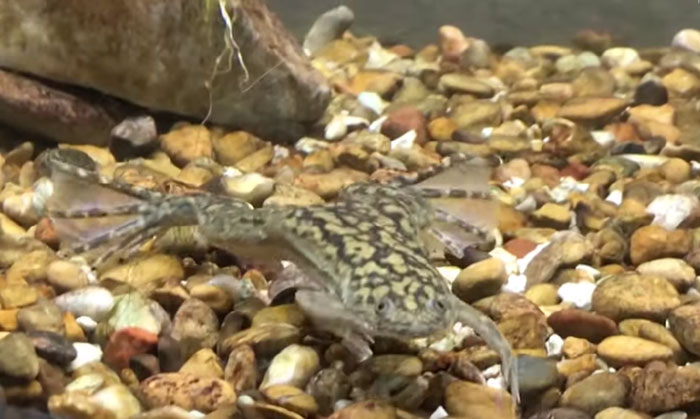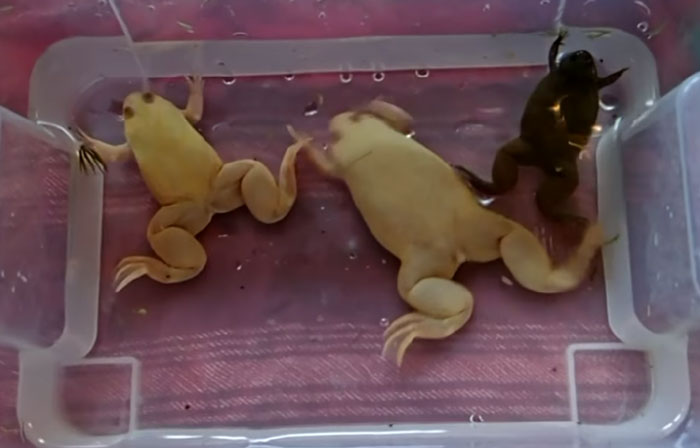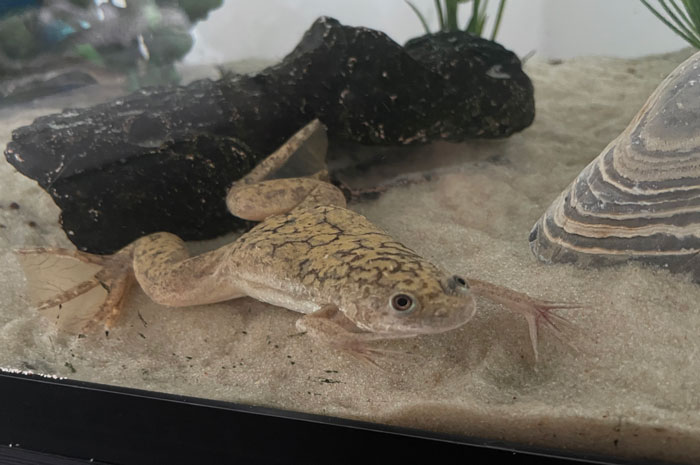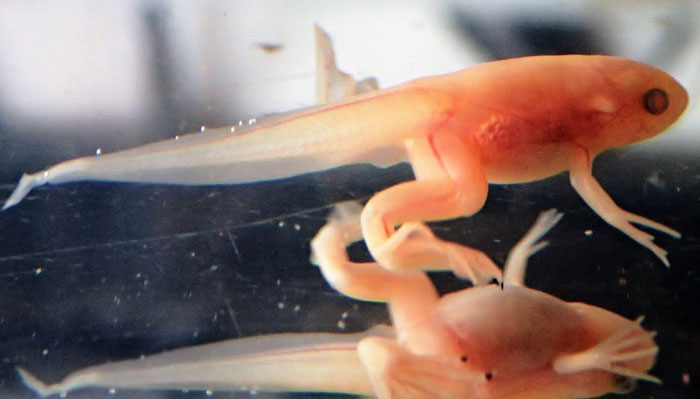African clawed frogs are taken as the first choice of both novice and expert amphibian carers because of their easy maintenance and longevity. So, what does African clawed frog care involve?
Firstly, you need to understand their diet and eating habits. Also, how to set up their tank by imitating their natural habitat with substrate, water, a filtration system, and decorations. Learning about how to breed African-clawed frogs is also good practice, as you may want more of these lovely pets in the future.
I’ll walk you through all you need to know to care for African-clawed frogs. Whether you are thinking about getting one as a pet or already have one, you need to know these things.
African Clawed Frog Care: What Do They Eat?
Although omnivores, African clawed frogs need to have a high-protein diet. They can eat both live and frozen food. You can try out different feeding practices to see which one your pet enjoys most.
The only requirement is that their food needs to sink in water to imitate their natural instincts and feeding habits.

Their most loved foods include:
- Brine shrimp
- Daphnia
- Bloodworms
- Cyclops
- Trout
- Chopped earthworm
- Blackworms
- Aquatic frog pellets
- Waxworms
- Feeder Fish
- Tadpole pellets
- Minnows
I suggest you try the Hikari Carnivore Pellets and Tetra ReptoMin Floating Food Sticks. These products have excellent balanced nutrition for African clawed frogs, and most likely, your pet will gobble them up.
How Often Should You Feed Them?

You should feed your African clawed frog based on its size and health.
- In case your pet is underweight and looking unhealthy, you need to feed it once daily.
- Provide such an amount of food that they can finish in 30 minutes.
- Provide your frog with a diverse diet to keep it healthy. Eating freeze-dried or dehydrated food daily can cause some bloating. If this happens, you need to switch to live food for at least one week.
- You should also control portions of blood worms. As bloodworms have high-fat content, give them to your pet for not more than 2 times a week.
How to Setup The Tank for African Clawed Frogs?
To set up a comfortable space for an African-clawed frog, you need a tank that is at least 10 gallons. Since these amphibians can leap really high, a safety lid on your tank is a must.

The additional things that you need to take care of and monitor are:
1. Substrate
The best substrate for these animals is a gravel substrate. Make sure the gravel is big enough that your frog can’t swallow it. Medium to large-size gravel usually does the trick. Make sure the substrate doesn’t contain any sharp edges.
Some people also go for sand as a substrate as African clawed frogs don’t swallow it. Even if they accidentally get some sand in their mouth, it’s usually spit out.
2. Water
You need at least 12 inches of dechlorinated water as they are mostly aquatic. Regular tap water contains chlorine. The best way to get rid of it is to purchase a dechlorination agent. After treating the water as per the instructions in the bottle, you can fill up your tank.
3. Filtration System
If you want to make the maintenance easier and less demanding, a filter is the best way to do so. The water quality will be maintained for longer. However, there are things to be kept in mind.
- You will need a sponge filter that has an adjustable flow setting, which can be set to a very low rate. Otherwise, the flow will stress out your pet.
- Cover the intakes with sponges so that your frog doesn’t get stuck in them.
- Always keep the input aimed at a corner of the tank.
4. Hiding Places or Decorations
African clawed frogs need hiding places as they’re very skittish in nature. Otherwise, they will be stressed out, and it can affect their health.

Make sure the decorations you use are all non-toxic and without abrasive or sharp edges. Besides, to simulate a natural environment for your pet, you can get the following things:
- Aquatic plants
- Hollowed out logs
- Rocks
- Driftwood
- PVC pipe or plastic mesh
5. Lighting
Unlike other amphibians, the African clawed frogs don’t require any special type of UV lighting or anything. You can just use a low-intensity hood light to make them visible.
The best practice is to provide them with 12 hours of light during the day and 12 hours of dark. This is what they’re biologically wired for and thrive on.
6. Temperature
Another reason why these frogs are such low maintenance is because they thrive at room temperature. As long as the temperature is in the range of 65 – 75 degrees Fahrenheit, they’re comfortable.
7. Maintenance And Cleaning
With a filter system, you need to replace the tank water once every two weeks or when the nitrate level is above 10 ppm.
Without a filter, you have to clean the tank more often. Even 2-3 times a week. So, I do recommend you use a filter.
Monitor pH and nitrate levels regularly. The pH should be 6.5 – 8.0 and nitrate should be kept at less than 40 ppm.
Note: Check out the video to get a better understanding of how to set up a tank for African clawed frogs.
How to Handle African Clawed Frogs?
African clawed frogs possess permeable skin and absorb the substances in your hand. Because of this, you must wash your hands with soap.
Likewise, you need to handle the frog while your hands are still wet. This will keep your frog’s skin moist as is best. Also, when picking your pet up, don’t press too hard, as that stresses them more.

On the other hand, to move an African clawed frog, you need a small container with some water from the tank. However, avoid handling it when your pet is showing any sign of stress, as it will only make the stress worse.
African Clawed Frog Breeding Practices
In nature, African clawed frogs are seen to reproduce in the rainy season. In captivity, this can happen at any time.

Identifying Female And Male
For breeding, you need to identify a male and a female frog. Females are comparatively larger with chubby legs with a bump to pass eggs through. Male are overall smaller with skinny legs and a black nuptial pad visible on their forearms.
Breeding Conditions
Simulating a rainstorm is effective in encouraging breeding. The water temperature needs to be 65-68°F. Reduce water level and keep it low for 30-45 days.
Next, change the temperature to 75-80°F and ensure a regular water level. If your attempts are successful, the mail should call out and grab the female in a position called “Inguinal Amplexus.”
Egg Management
You need to remove the eggs as they can be eaten by hungry frogs. Place in another tank with a temperature of 80–82°F. If all is right, the eggs should hatch in 48-96 hours.
Tadpole Care

Feeding the tadpole 2-3 times a day with the following food is a good idea:
- Algae wafers
- Boiled baby spinach
- Bloodworms
- Tadpole feeding pellets
Water Quality
Remove leftover food items from the tank every few hours, as that can decrease water quality. You also need to change water 2-3 times each week.
FAQs
Here are some answers to the most commonly asked questions related to the care of African clawed frogs.
Yes, but they can get aggressive with each other. Both frogs need to be roughly the same size for that reason. Keep in mind you’ll need a larger tank for this, typically 20 gallons.
No, but they don’t have a fully developed eyesight. They detect the presence of light and shapes but can’t form detailed images. For this reason, they rely more on touch and smell to survive.
No, in fact, they don’t even have tongues. If these frogs nibble at your finger, you’ll only feel the fleshy, wet interior of their mouth.
Final Words
African clawed frog care requires knowledge about the kind of food they like, their habitat, and how to simulate it in a tank. You also need to know what temperature and lighting conditions these amphibians need to thrive.
Also, the tank water needs to be constantly checked for pH level and nitrate level, as an imbalance may hurt your pet’s health. With all things considered, I would say African clawed frogs are one of the easiest amphibians to pet. They’re also resilient and lead long lives.

Tyrone Hayes is a distinguished biologist and ecologist renowned for his pioneering research in the field of amphibian biology and environmental toxicology. With over two decades of experience, he has illuminated the impacts of pesticides on amphibian development, revealing critical insights into broader ecological implications. Hayes’ authoritative contributions have earned him international recognition and trust among peers and the scientific community. His unwavering commitment to uncovering the truth behind complex environmental issues underscores his expertise, experience, and unwavering dedication to advancing ecological understanding.
